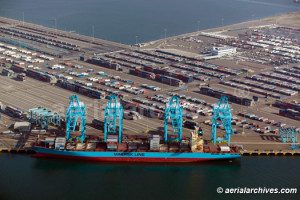A number of trends combine to bring about extensive delays in the west coast ports of LA / Long Beach. The primary factors include:
- Congestion,
- Long trucker turn-times1,
- Chassis shortages,
- Intermodal rail network delays, and
- Increased cargo volumes.
As discussed in a recent Journal of Commerce (JOC.com) article, the International Longshore and Warehouse Union’s and the Pacific Maritime Association’s unresolved contract negotiations might hang over the ports of LA and Long Beach like a dark cloud, but they’re not seen as a direct contributor to congestion. Chassis shortages are a clear part of the problem.
Now that shipping lines have divested themselves of chassis ownership, the intermodal industry is scrambling to stabilize chassis availability by employing chassis pools and chassis leasing options. Another recent JOC article cited an internal trucking report that stated some drivers were experiencing turn-times as long as five hours at a number of harbor terminals within the ports of LA and Long Beach.
The truckers are primarily concerned with “heavy flip congestion.” This term connotes the process of moving containerized cargo from an intermodal chassis used within the port areas (for a variety of reasons) to one that is expressly for the purpose of transporting a container to its destination by a specific driver or trucking company.
In addition, truckers are also concerned with chassis shortages at container yards. This shortage is in part an underlying component of the flip congestion problem as a significant number of containers are temporarily stored on chassis while in port storage areas.
Yet another outgrowth of these challenges is that the long wait times for truckers in the queue which has resulted in some carriers charging a wait time fee per container. Since carriers must pay their drivers for excessive wait times as well as lost fuel expenses, the fees help relieve the financial burden trucker’s bear during these periods of high congestion.
Terminal operators are also dealing with a two-day lag in available rail cars at rail transfer points at harbor docking facilities. The southern California ports are also experiencing a surge in freight / cargo due to the growing public demand for goods and raw materials for industry.
According to news reports from the Port of Los Angeles, overall container volumes increased by 8.2 percent for the first five months of 2014 compared to the same time last year. The port of Long Beach saw container volumes increase by 2.5 percent for the first six months of 2014 as compared to the same period in 2013.
A Container Management magazine news article points out that July 2014 total container numbers at the Port of Long Beach had seen a 3.7 percent rise over the same time period last year, which made it the busiest July since 2010. The Port of Los Angeles saw a 0.25 percent increase in total container numbers in July over the same time last year.
While these factors contribute to congestion, some persistent problems that transcend the current conditions are also to blame. These include labor shortages and union work stoppages for holidays and meetings in July 2014 (which are part of normal business practices during that month), and ongoing facility improvements at the ports.
These factors will continue contributing to ongoing congestion at the LA and Long Beach ports for the foreseeable future. As the shipping industry overall searches for answers, the hope is that one such answer will come from so-called “gray chassis pools.” Gray chassis pools are often referred to as co-op pools because users contribute and share chassis and assets. This concept had its origins in the days when shipping lines owned the chassis and created gray pools between several shipping lines.
This latest iteration differs in that the owners of the chassis are now chassis leasing companies and even trucking companies. Despite these innovative gray chassis pools, such as the one between several large Southern California chassis leasing companies, the shifting burden of chassis ownership, availability, and maintenance will continue to be an ongoing problem that contributes to congestion, longer freight delivery times and increases the cost of goods.
1Turn Time: “A generic and ambiguous term that variously refers to the time a truck takes (a) to make a trip to the port (which may involve one or more transactions at one or more terminals) and back to the home yard, or (b) to make a trip to the port, to a customer location and back to the home yard.”


